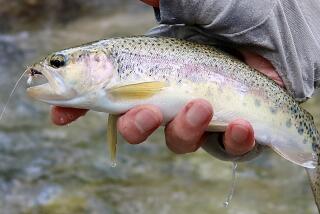Illness puts trout-fishing industry in hot water : Outbreak of whirling disease across Rockies is destroying fry and spawning a political controversy.
BLACK CANYON OF THE GUNNISON RIVER, Colo. — When spring comes to this fly fisherman’s nirvana, wild rainbow trout instinctively gather over gravel beds and use their tails to fan depressions in which to lay their eggs.
Within a few weeks, the eggs are fertilized in these protective pockets of sand and pebbles. In June, upward of 20,000 fry per mile wiggle free of their yolk sacs and swim into shallow waters sheltered by black granite cliffs.
In past years, the seasonal rhythms of the Gunnison’s wild rainbow trout led to adulthood and new broods.
Not anymore.
By December, nearly all of these young fish will be dead, victims of a mysterious, lethal and seemingly indestructible pathogen that recently moved into this southwestern Colorado river.
*
Barry Nehring, a state fisheries biologist and avid fly fisherman, recalls the day in August 1994 that he first noticed signs that the Gunnison was infected with whirling disease, which attacks the cartilage of fry and causes deformities that force them to spin like dervishes until they die.
Gazing at the swirling waters, he said: “I saw baby trout spinning like runaway boomerangs and it was like getting slugged in the stomach by Mike Tyson. This was my favorite fishing spot for 15 years.”
For unknown reasons, the usually benign disease now found in 21 states is suddenly smashing wild rainbow trout populations across the Rocky Mountain region. Montana’s fabled Madison River and stretches of the upper Colorado River have suffered declines of 90% in the past few years.
Colorado has been especially hard hit. Since it was introduced here in 1987 by infected hatchery rainbows let loose in tributaries of the upper Colorado River, the disease has spread to 13 of the state’s 15 major river drainages.
Why the disease is killing wild rainbows here and not in other places, such as Northern California’s Truckee River, where the pathogen was first detected in 1968, is one of the mysteries fisheries biologists seek to unravel.
One thing seems clear: Fishing in the Rockies may never be the same because whirling disease is disrupting the delicate balance on which wild trout management here is based--protecting habitat while supporting the lucrative trout-fishing industry.
Before whirling disease was discovered here, state and private hatcheries stocked at will in rivers and lakes for the benefit of the million anglers who annually generate $900 million in revenues. By the time biologists traced reproduction crashes in wild rainbows to hatchery fish infected with the disease, it was too late.
*
Now, some believe that the battle to eradicate the infection will only get harder in states like Colorado, where hatchery operations have the most to lose.
On one side of what has become a political controversy are fisheries biologists worried about losing reproducing populations forever and angler “purists” who yearn for the thrill of having a wild rainbow trout shake an artificial fly in a Rocky Mountain stream.
“Who wants to see distorted, slack-jawed, snot-nosed trout while on vacation in the Rockies?” groused fly-fishing enthusiast Ann McIntosh, who writes for Trout Fishing magazine. “We expect to find clean air, clean rivers and mountain lakes and clean fish. Having sick animals in the water is not part of the Rocky Mountain image.”
Facing the loss of that cherished image--and the virulence of the disease--Colorado wildlife officials are considering new guidelines for public and private hatcheries. They could include disinfecting hatchery water with ultraviolet light, covering ponds with netting so that birds cannot eat infected fish and carry the disease elsewhere, and lining earthen bottoms with concrete or plastic to get rid of the parasite’s host worms.
Hatchery owners, however, argue all that would be money down the drain because the disease, once established in nature, is all but impossible to eradicate. Beyond that, they say, such costly improvements would drive some hatchery operations out of business and hurt the majority of average fishing enthusiasts who do not care whether the fish they catch are wild or stocked.
*
“The elitists who use artificial flies to catch and release wild fish don’t like us one bit,” said Greg Brunjak, general manager of central Colorado’s Mt. Massive Lakes hatchery and president of the Colorado Aquaculture Assn.
“But what about the average Joes who want to take their kids out to dunk a worm somewhere and take a fish home? Without hatcheries there will be no fishing anywhere for them,” he said, “and the disease will still be there.”
Fisheries biologists have begun research into developing potentially resistant strains of trout, as well as into the life cycle of the pathogen, how it is spread and how it can be quickly detected.
In February, 400 of the world’s top trout-management experts gathered in Denver to pool information.
“Our hope is that by the year 2000, all of our hatcheries will be parasite free, or close to it,” Nehring said. “But our rivers and lakes won’t be. I’m not certain we’ll ever put an end to it there.”
More to Read
Sign up for Essential California
The most important California stories and recommendations in your inbox every morning.
You may occasionally receive promotional content from the Los Angeles Times.










